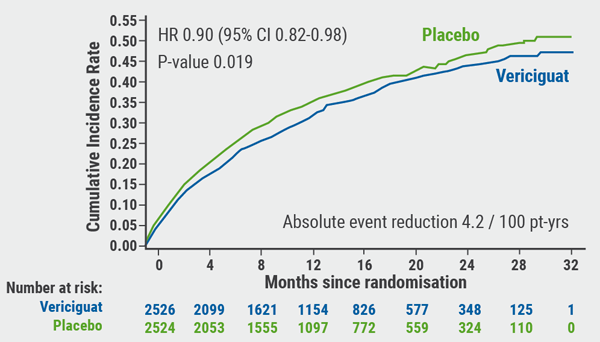Prof. Mario Gaudino (Weill Cornell Medicine, USA) presented the results of the RADIAL study, which was a patient-level combined meta-analysis of 5 clinical trials held in Australia, Korea, Italy, Serbia, and the United Kingdom [1]. The rationale of this combined analysis stems from the fact that the use of >1 arterial grafts for coronary-artery bypass grafting (CABG) has not been widely adopted despite current guidelines recommendations. It is generally accepted that radial artery grafts have a better patency rate compared with saphenous vein grafts. Yet, evidence has shown that patients frequently receive saphenous vein grafts in addition to an internal thoracic artery graft to the left anterior descending coronary artery [2]. "The choice of an artery or a vein to create the second bypass is one of the most important unresolved questions in contemporary bypass surgery," Prof. Gaudino said.
For the RADIAL meta-analysis, the investigators combined the results from 5 trials in which patients receiving bypass surgery were randomly assigned to get a second bypass from either the radial artery (n=534) or the saphenous vein (n=502). Participants had an average age of 67 years at the time of surgery; 70% were male. The primary endpoint was the combined rate of death, heart attack, or need for a second procedure to treat the same artery. The co-primary endpoint was the combined rate of death or heart attack.
In 2018, this team previously reported in the New England Journal of Medicine that after an average 5-year follow-up, patients who received radial artery versus saphenous vein bypasses had significantly fewer heart attacks and repeat revascularisation procedures, although the death rate was similar in the 2 groups [3]. The current study extends that study by an additional 5 years of follow-up from the same patient cohorts. At a median of 10 years follow-up, patients who received radial artery bypasses had a 23% reduced risk of experiencing the primary or secondary endpoint event when compared with the saphenous vein group (HR 0.77; 95% CI 0.63-0.94). Use of the radial artery was associated with a 27% reduction in deaths (HR 0.73; 95% 0.61-0.88; see Figure), a 26% reduction in heart attacks, and a 38% reduction in repeat procedures. In a subgroup analysis, females had better survival with radial artery grafts compared with saphenous vein grafts (HR 0.51; 95% CI 0.36-0.72) than males (HR 0.84; 95% CI 0.68-1.05).
Figure: Cumulative incidence of the primary composite outcome in the radial artery (RA) versus saphenous vein graft (SVG) groups [1]

Prof. Gaudino concluded that although the results from RADIAL are a pooled analysis of several small trials rather than 1 large trial, the ongoing ROMA trial will hopefully confirm these data in a larger and more homogenous setting. ROMA aims to test whether outcomes are better for patients who receive 2 or more arterial bypasses compared with patients who receive just 1 in a cohort of 4,300 patients. Initial results are expected in 2025.
- Gaudino M, et al. Abstract 410-12. ACC/WCC 28-30 March 2020.
- ElBardissi AW, et al. J Thorac Cardiovasc Surg 2012;143:273-281.
- Gaudino M, et al. N Engl J Med. 2018;378(22):2069-2077.
Posted on
Previous Article
« PCI and CABG are equal in left main CAD Next Article
Renal denervation better than sham for blood pressure »
« PCI and CABG are equal in left main CAD Next Article
Renal denervation better than sham for blood pressure »
Table of Contents: ACC/WCC 2020
Featured articles
Heart Failure and Cardiomyopathies
Mavacamten shows promising results in non-obstructive hypertrophic cardiomyopathy
Vericiguat shows beneficial effects in a very high-risk HF population
No role for sodium nitrite in out-of-hospital cardiac arrest
Vascular Medicine and Thromboembolism
Rivaroxaban and aspirin effective and safe for PAD patients
TAILOR-PCI misses endpoint but still provides valuable insights
Edoxaban: alternative to warfarin after surgical aortic or mitral valve procedures?
Bleeding reduction post-TAVI with OAC alone vs OAC + clopidogrel
Apixaban offers new perspective for cancer patients in need of anticoagulation
Rivaroxaban superior to enoxaparin in preventing VTE in non-major orthopaedic surgery
Interventional Cardiology
TAVR safe and effective in low-risk bicuspid aortic stenosis patients
TAVR model reveals differences in hospital outcomes
2-year results show non-significant outcomes TAVR vs surgery in severe aortic stenosis
Renal denervation better than sham for blood pressure
Infusion of ethanol in the vein of Marshall for persistent AF
Atrial Fibrillation/Acute Coronary Syndrome
Fewer adverse events with ticagrelor monotherapy after 3 months DAPT
TWILIGHT sub-study: same outcomes for diabetes patients
TWILIGHT sub-study: complex PCI patients
LAAO Watchman registry data positive
Apixaban in AF patients with recent ACS/PCI: Drop aspirin after 30 days
Genetics and Prevention
Homozygous FH responds to alirocumab
Evinacumab significantly reduces LDL-C in homozygous FH patients
Higher serum levels of eicosapentaenoic acid correlate with reduced CV events
Quit smoking: vaping + counselling helps
Related Articles
September 8, 2020
Fewer adverse events with ticagrelor monotherapy after 3 months DAPT

September 5, 2020
ACC.20/WCC Highlights Podcast Part 2 of 3

September 7, 2020
Vericiguat shows beneficial effects in a very high-risk HF population
© 2024 Medicom Medical Publishers. All rights reserved. Terms and Conditions | Privacy Policy
HEAD OFFICE
Laarderhoogtweg 25
1101 EB Amsterdam
The Netherlands
T: +31 85 4012 560
E: publishers@medicom-publishers.com

